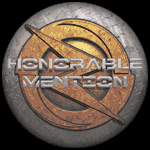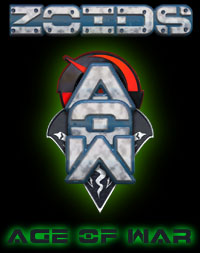RHEGANI
Tribal Matriarchy

XZ-109 Askari
Chassis: Driver Ant
Power Plant: XSZ1 (Standard Zoid – Class-A4)
Primary Mission: Attack Response System
Secondary Mission: Search and Destroy
Crew: 1 - Pilot/Gunner (minimum rank requirement: Ensign)
Statistics
Length: 18.5 meters
Width: 13.25 meters
Height: 7.5 meters
Mass: 34 tons
Performance
Speed: 190 Kph
HISTORY
The Askari is the latest form of main defense unit of the small island jungle nation of Rhegani. The Zoidarians of Rhegani have always relied on lighter armor to maneuver through the twisted terrain of their lands, and the best Zoids for their cause have proven to be insect-based chassis. Centuries ago they relied on refitted Guarantula for this role, but as neighboring powers began to rely on faster Zoids, usually with feline chassis, the need arose for a faster and more nimble defender. Rhegani purchased a well worn Twin Sworder from Helic in order to study the insect drive systems, but it was found even limited flight capacity was a hindrance. The first prototype was the 20 ton Siafu, which was light and fast but carried little armor and the weapon systems were found to be inadequate against evolving adversaries. After three more renditions the platform was extended to the current chassis with enhanced carriage, improved armor, and a greater weapon load. It was named “Askari” by a visiting Helic major, meaning “soldier” in Swahili.
DEFENSES
Unlike its predecessor, the Siafu, the XZ-109 Askari holds more than twice the volume of armor. It is applied on a “center mass” approach; head, thorax, abdomen, and first leg segments. To retain speed and agility, the outer legs have retained a skeleton architecture similar to the Helic and Zenevas insect units. Head armor is reinforced, the pilot held safe within an inner skull which is buried inside the angular external armor. The head can also be ejected from the body if required, giving Askari pilots an exceptional chance of survival among light Zoids. The abdomen has layers of flexible armor shields that allow it to employ ECM measures or close to endure direct fire. All torso joints have reinforced armor cowlings.
CAPABILITIES
The Askari is designed to charge through heavy undergrowth and thread between enormous trees, cross ravines and rushing rivers, all at 100 KPH at minimum. In even somewhat open terrain the XZ-109 can achieve speeds up to 190 KPH. The machines can climb vertically if a surface is capable of holding the weight. Its standard communications arrays fold away to protect them from damage due to environment or incoming fire. On the right side of the thorax is a 360° LAR (Locate And Respond) sensor array that aids in navigating in any conditions and can find an active machine within 25 kilometers. The abdomen carries further sensor and communications equipment.
ARMAMENT
The primary configuration of the Askari is designed to snipe heavier enemies from a distance or close in to unleash direct firepower on lighter units. Rhegani knows it may one day stand against more powerful foes with much larger military budgets, and so the XZ-109 is essentially designed to sweep away multiple lighter Zoids at once and tangle effectively with units more than twice its size. In even small groups, the Askari is capable of whittling down even the powerful Iron Kong.
80mm EMHV Bolt Cannon – torso mounted, 360° rotation, 140° elevation
Hanging off the left thorax of the XZ-109 is a rather imposing weapon, and it’s mainstay on the battlefield. The Electro-Magnetic Hyper-Velocity bolt cannon was specifically designed to pierce very heavy armor and shred softer internal systems, allowing the Askari to engage units such as the Imperial Saber. It fires a dense, semi-guided, 2.25 kilogram round with a diamond tipped titanium penetrator at speeds exceeding MACH 5; capable of piercing almost any conventional armor. A tenth of a second after impact a charge in the center of the round explodes, sending shards of shrapnel out under the target’s skin. The EMHV requires a bit of cooling and recharging, but can fire up to 3 rounds in succession in under 10 seconds before resting. The gun swivels 360° and is excellent for sniping at large enemies through foliage as the Askari darts about. The standard magazine holds 50 rounds but an alternative system hangs a double-load magazine on the gun, granting 100 rounds but slowing targeting by 20% due to the increased weight. The EMHV has an effective range of up to 7 kilometers with almost assured armor penetration closer than 3 kilometers.
50mm Laser Cannon (x2) – abdomen mounted, rear arc, 45° rotation, 45° elevation
A standard weapon designed to deliver damage by superheating the target area, Askari lasers fire an extended beam that lasts for up to 2 full seconds. Against lighter targets these guns can ablate common armor, armored coil lines, and melt hydraulic cylinders is a quarter of a second, but the pilot can opt to retain a shot against larger targets and still hope to cause significant damage. This is especially true when the two guns are engaged as a unit. The 50mm laser cannon can cause effective damage up to 3 kilometers away.
40mm Laser Cannon (x2) – head mounted, forward arc, 90° rotation, 60° elevation
Lighter than the rear mounted weapons, the 40mm cannons are used on light armor and structures. Combined with the natual agility of the Askari they can also target aerial units. The 40mm laser cannon cause slightly lighter damage up to 2 kilometers away.
“Roughshot” 35mm Can Grenade System – thorax mounted, forward arc, fixed
Primarily intended as a defensive measure, the Roughshot is a 3-barrel lofting grenade launcher that can also fire airburst anti-personnel or light armor defeating rounds. Each barrel is equipped with a small magazine of 3 rounds and the entire unit can eject after all 9 are spent. Most commanders have one magazine loaded with anti-personnel, one with chaff, and one with smoke.
“Hailfist” 25mm MFR Pod (x2) – abdomen mounted, forward & aft arc, 360° vertical rotation
The Hailfist is mounted on either side of the abdomen module, usually in pairs. Each pod holds eight 25mm rockets and can be ejected after expending all ammunition. Each rocket is capable of striking a target up to 5 kilometers away with good accuracy, lancing straight through light armor. Heavier units can look forward to the super-heated SABOT warhead spraying 6,000 degree liquid metal on impact.
Saw-Pincer Alloy Jaws – head mounted, forward arc, fixed
These jaws open extremely wide and can dismember even large Zoids before their pilots realize the error of attempting melee combat with the Askari.
AI-2 PROFILE
The XZ-109 Askari is a very simple Zoid, lacking AI-2 technology. Rhegani is currently negotiating with Helic to acquire AI-2 for the next rendition. Currently the Askari boasts what Rhegani military engineers have dubbed the T3-PAS; Tactical Terrain Threading Pilot Assist System. This is a CPU that detects environmental factors and controls every joint of the Zoid to the pilot's chosen destination. Pilots maintain that they need only point it in the right direction and the XZ-109 glides quickly across, under, and around almost any obstacle with unnerving ease. This was a requirement as it allows the XZ-109 to charge to a waypoint through twisted jungle terrain and leaves the pilot frree to track with weapons. Alternatively, the pilot can manually press the machine forward and designate targets which the Askari's weapons then track and fire upon in moments of opportunity.
ZOIDS PARTS LIST
Sacurtis
motor, legs, head armor, mandibles,
40mm abdomen laser cannons, caps
Zabat
cockpit
Aerosaurer
head weapon mounts, EMHV magazine details
Gorhecks
rear legs
Gul Tiger
EMHV magazine, caps
Dispelow
abdomen Blox
Red Horn
EMHV support unit, abdomen sensor array
Saber
abdomen sensor array
Gustav
EMHV barrel & mount, drive train detail (cap)
Shield Liger
8-shot MFR pods
Robostrux Kreep
thorax sensor mount
Godos
30mm head laser cannon
Gojulas
EMHV magazine ammunition belt (cap)
Spinosapper
thorax sensor mount (cap)
NON-ZOIDS PARTS LIST
Plastic Spoons
thorax & abdomen armor
Asoblocks
leg joints & armor, neck joint & head armor
thorax extension, drive train
Struxx
propodeum, petiole, MFR racks
Robart Hinges
antennae, mandible joints, leg hydraulic joints
Polystyrene (card & tube)
thorax internal structure, abdomen details,
rear leg extensions & hydraulic components,
EMHV magazine & hinge pin cap, mandible blades
Bionacle
EMHV flash diffuser
Warhammer 40,000 Land Raider
EMHV support rail & sensor array,
thorax sensor array & support,
35mm can grenade launcher,
armored rebreather
Kotobukya Display Stand Mk2
EMHV magazine mount/power integrator
Zip-Tie Latch
mouth parts/head mounted array
Small Necklace
EMHV, sensor suite, & rear leg power cables
abdomen & thorax hauling lugs, tow cable,
EMHV mount detail
Large Necklace
abdomen/drive train power cable,
abdomen load clasp
Steel Hinge Pin
EMHV hinge pin & magazine handle
Aluminum Tubing
rear leg hydraulic pistons
Brass Tubing
rear leg hydraulic cylinders
SUMMARY
Askari have proven themselves very capable field units with an excellent balance of speed, maneuverability, firepower, sensory, and defensive systems. Even without considering the limitations of the small nation of Rhegani, the XZ-109 is an incredibly effective Zoid design which can be devastating if it is well implemented. Its primary pitfall lies in somewhat difficult and costly maintenance which must be vigilantly applied due to the combination of rugged environment and advanced technology; seldom good bedfellows.
SUMMARY
Once upon a time, there was an ant. This ant was of little consiquence, until it was joined by a multitude of little, inconsiquenial ants. Together, these lightweight critters formed an army that could shred virtually any living thing to raw bones in a matter of hours. The ant was called, "siafu", also known as the Kenyan driver ant. I had long thought I should do an ant custom; one a little more ambitious than most of those I had seen. One that was fairly true to the original animal, made an effective Zoid, and also paid homage to a type of weapon platform that we see slowly taking over our world; the multi-role light armor vehicle. These are faster and more nimble than a tank, and often they are better armed. I had an old NJR Saicurtis... it was time to operate.
THE BUILD

THORAX
After searching around for a decent solution for the ant's armor, the most obvious choice was in a set of black plastic party spoons left over from my wedding at the start of this year. I guess that makes the Askari a sort of 1st Anniversary wedding Zoid. :-) Now, the thorax posed an interesting design challenge; the Saicurtis motor has a cog that lifted and set down the wings, and it prevented any armor from lying flat on it. I decided that this wasn't an obstacle, it was a feature. I wanted to stay as true to the animal as possible, and that meant building directly off of the motor. In the second shot you can see I mounted two kinds of ball and socket joints on the motor; the rear is a Struxx socket, the front is an Asoblock ball joint. The Struxx ball joints were heavily modified to make a double joint between the thorax and abdomen, seen in the last image and again in the next picture set, below. These also formed the propodeum and petiole, structures common to most species of ant, which added a great deal of realism to the build. The front unit has a styrene skeleton to uphold the armor, seen in the third shot. I drilled out and smoothed a hole for the wing cog, then shaped the spoon to make room for the socket. The last picture shows a concept I was playing with to mount a searchlight or sensor dish through the armor. A final touch; an extra piece of spoon was placed on the undercarriage against the motor that smoothed the lower shell.

HEAD
One of the most distinctive features of the siafu ant is its squared-off head with two nub-like "horns" at the neck and the fact that the ant is eyeless. It also has large, cross-hook jaws and 3-section antennae. I first gathered up the parts I thought would work well for the head, then cut up the Saicurtis shell to make the new head armor and mandibles. I took a Godos twin AZ machinegun and separated the weapons in order to mount it under the head. The second picture shows the pieces being set aside to gauge where they would work best. I set these parts around six different types of Zoid heads to see which felt the most true to the insect. Ironically, it was the Zabat head that fit... the only one that would be blind. The last two photos show the finished head with jaws and antennae flexed closed and opened.

LEGS
While only slightly modified legs worked well for the front two pairs, the rear legs of an army ant are much longer in comparison. This required a bit of enginuity and the help of a Gorhecks... and some styrene tubing... and some alluminum piping... and some brass piping. And some nylon hinges. And an Asoblock. And the USS Arizona. One aspect that makes this project unique is that it's the first time I've scratch built complete hydraulics from metal., and I fear it will become a staple of future builds. The Saicurtis legs had to be trisected; the first segment extended with square and round styrene tubes and an Asoblock ball joint and the second segment re-attached. A new, functional knee joint had to be built from the Gorhecks parts. Also, a new ankle was made by cutting a slot into the Gorhecks piece and an observation tower from the Arizona made a perfect gear. The Saicurtis' foot was then greatly modified with extra protrusions sliced, the toes sheered off and split, and the ankle cut out to make room for the new gear. Finally, fitted a pair of hydraulics to each rear leg. These would function if the original leg hinges were cut to pivot; for now they are simply to look really cool. :-)

This first image compares the new rear leg to the original Saicurtis leg. Extended, it would be twice as long. I really like the finished product! The second shot above shows the much simpler modifications to the front four legs; the tab was shaped and fitted into an Asoblock and the foot cut down into a more tapered, ant-like form with a split toe. The bottom of each foot was also shaved, which raised the overall angle to hold the body higher. Finally I modified the Asoblock into a ball-and-peg that fits into the motor's original hip joint holes. This allows each leg to rotate 360° in addition to having a ball joint, and it further raised the Askari in the air. All together, the legs are very poseable and sturdy, and the Askari can still walk... a bit sideways.

BODY STRUCTURE
Playing with the body shells of the Saicurtis was actually a catalyst in building an ant. As you can see in the first two photos, my original concept was to use an spare original Helic head, but it never felt right. After looking over many images of ants and observing the Saicurtis parts, I decided to rotate the motor 90°. I had seen a customs done using plastic spoons for an abdomen before, and it seemed the logical choice for my ant. For the joining thorax joint I decided to use a large Struxx ball joint; it looked the part and prevented me from having to design a small segment which would likely have been static. You can see in the final build that all aspects of the structure were lengthened and tapered, and that the Struxx joint added great flexibility.

ABDOMEN
The final body segment started out as a very simple plan indeed; take two black spoons, have them face each other, and put something between them. This looked fine, but it also looked boring. I ended up carving up 8 spoons to make the abdomen armor segments, then mounted them on top of another pair of spoons for internal structure. Each spoon was sanded with 600+ grit sandpaper to aid in painting. I decided the best thing to use as the core of the abdomen was a Blox cube, which was shaved down to fit the contour of the armor. This also left me some Blox ports in case I ever wanted to swap out external weapons or cargo pods. You can also see a metal cable passes through the lower armor, linking the abdomen to the secondary drive train. Attached to the read of the Blox is a shaved Red Horn sensor array, seen in the second photo. The antenna was removed and its base drilled through, which allowed me to pass a cable spring through it. The large Saicurtis guns were glued to either side to afford the Askari some rear firepower. In the third photo you can see a pair of antenna units are glued above the Saicurtis guns to fill out the shell with more communications gear. I modified a pair of Shield Liger multiple fire rocket pods and fitted them into some Struxx frames for the MFRs, which can rotate 360°.

METALLURGY
Askari represents the most metal I have added to a custom to date. The photos above reference how much was used to build it, and I would have added several more pieces had I not run out of time for the Zoids Poison 2010 Custom Contest. First pic; the hydraulics are comprised of 8 pieces of metal tubing (4 aluminum, 4 brass), the second shows the metal handle on the EMHV cannon ammo magazine, the third is a hauling lug fitted in front of the motor just before the neck joint. In the fourth image there are two pieces; the obvious one is the necklace link tab on the sensor unit, added to just have a little more detailed on this part that I seem to use so much lately, and the second is at the top of the picture... the pin forming the EMHV joint. The next two images show the detail and function of the lower abdomen hauling lug; unlike the forward ring, this is the functioning clasp of a necklace, drilled through the shell and secured inside so it can rotate 360°. The lower image shows it securing a long necklace "cable". The final two pictures show the functioning clasp atop the abdomen, with the lower image showing how I use it to hold the cable in place. I love this feature because it rmakes the Askari seem very functional in the same way we secure loads and equipment to our modern military vehicles.

EMHV CANNON
I wanted the Askari to have an effective main weapon but not an overkill one. This cannon and mount was made to hang off-center to offset the sensor array, but it had to have a 360° swivel. The barrel and support post were cut from a NJR Gustav welder arm, the muzzle is a Bionacle peg, the red cooling system is a spare adapter from a Kotobukia model stand. The hinge and targeting system are from a Warhammer 40,000 Land Raider. I cut the welder from the arm, sawed it into a "Y" shape, drilled it, fitted the groove in the welder to the tab in the Land Raider piece, and pinned it with a steel hinge pin. After modifying the Red Horn targeting system to fit on the the thorax, I drilled the top and fitted the welder into the hole to make the pivot. Finally, I linked the two with a long, thin coil spring for an external power cable to complete the gun. It didn't look quite right to me, so I used a chunk shaved from a Gul Tiger leg as the foundation for a magazine. It was capped with sheet styrene and I cut segments around the unit to add interest. The two green circular pieces were shavings from the Aerosaurer parts I used to mount the antennae onto. The "bullets" took the form of a large, shaved Gojulas cap threaded so you can see the round in both the top and through the inside of the magazine. Finally, I added a steel wire handle. I love how it all turned out.

CAPABILITIES - (continued)
With six powerful legs, the Askari is an excellent platform for lifting or pulling large loads. Seeing this advantage early on, the engineers designed it with a Blox securing module that can support two lateral and one underside system. These can be cargo, infantry, weapon, or sensory units, making the Askari a very diverse and capable machine. Integrated into the armor of the Askari are various heavy lugs and locks for carrying even more loads and hauling. This configuration, with the addition of an armored rebreather life support unit, enables the XZ-109 to traverse the sea floor. It can achieve a speed of 40 kph submerged and remain underwater for up to six hours.

The head weighs as much as the thorax and has five articulating joints. The Aerosaurer parts really added a substance the head needed. I find it ironic that the Saicurtis armor looks as though it has large scowling eyes when set on their sides, since the Siafu has no eyes at all. The small (and rather cool looking) jaws are the lock of a large zip-tie.
SEMI-FINAL BUILD
These shots represent the completed build before I decided to add some final minor details, namely quite an array of metal parts that I will outline below. I am very pleased with the Askari; the form is very true to the anatomy of the subject ant, very Zoidlike in appearance, and very effective as a weapon platform. Its flexibility is outstanding, making it appear menacing in every possible pose. The details turned out quite high for such a small custom, with none of them being over the top. All in all, the Askari ranks up there with my favorite customs and is a thrill to display.

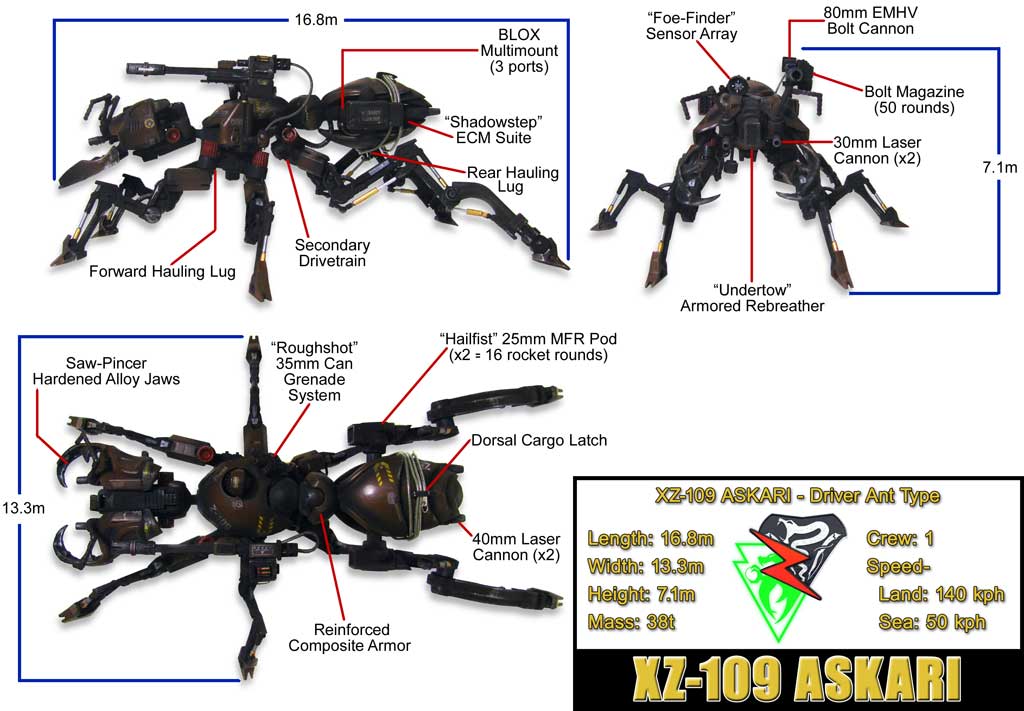
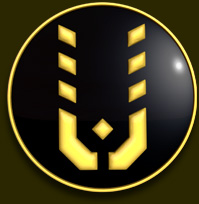
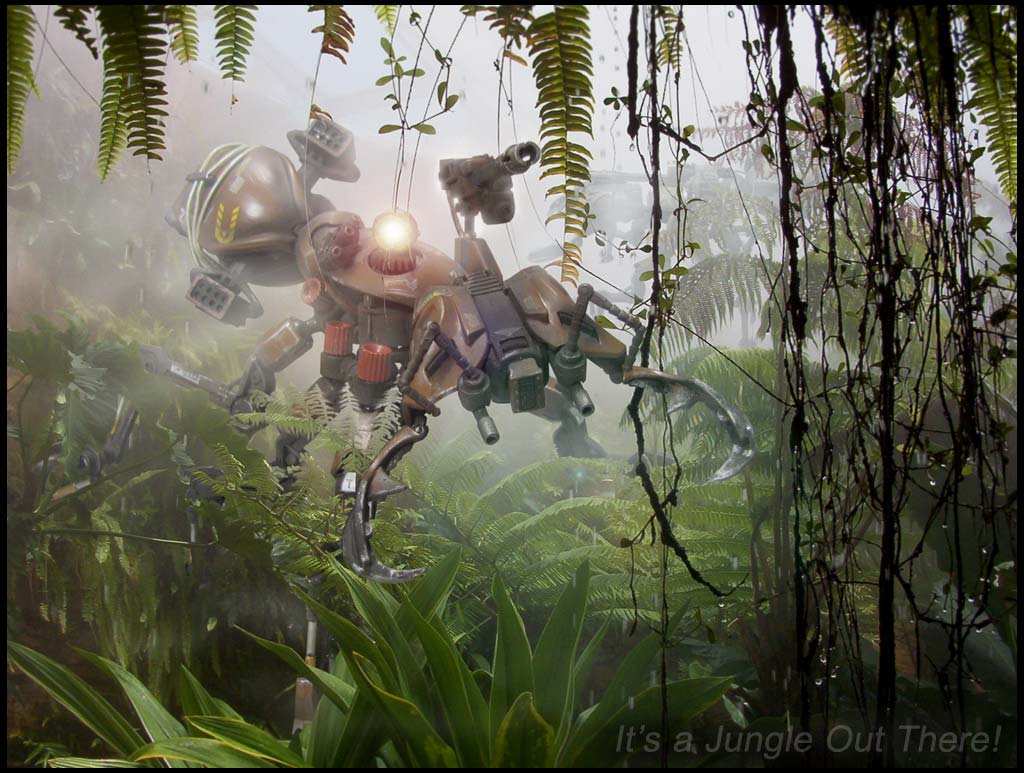

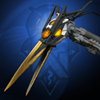

ENTRY: Zoids Poison Custom Contest - 2010

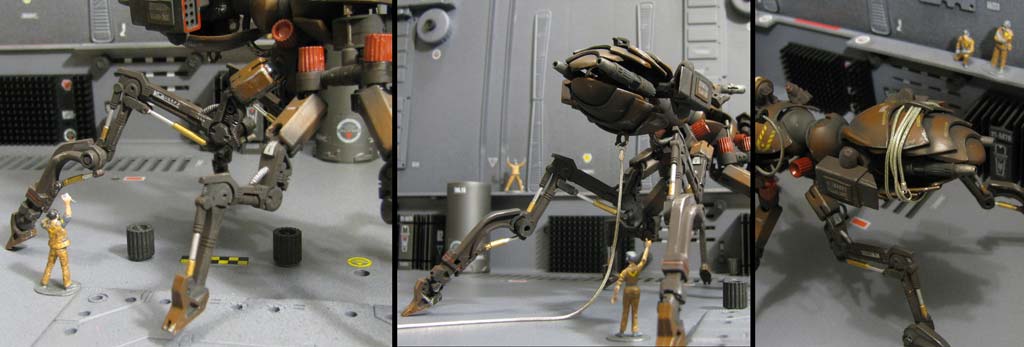


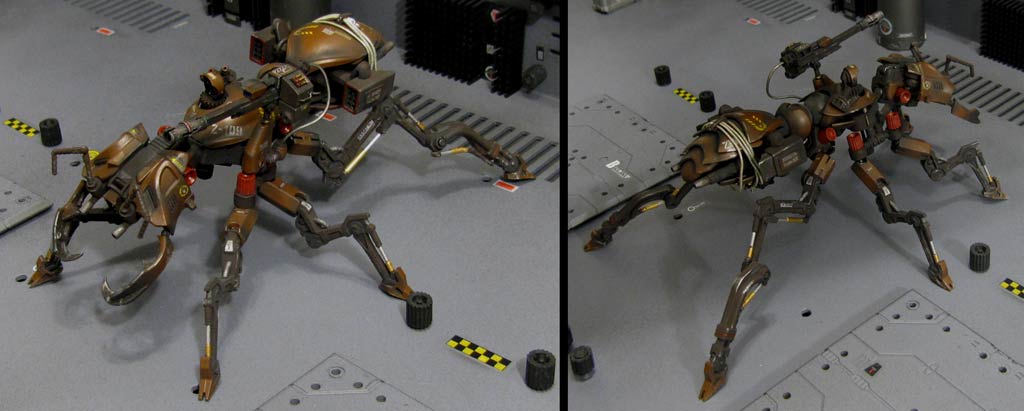
EMHV BOLT CANNON
The dreaded sting of the XZ-109 Askari, the Electro-Magnetic Hyper-Velocity bolt cannon. As a piece of projectile-based light artillery it is fitted with an ammunition magazine. As an extremely powerful energy weapon it must also be piped directly to the Askari's core. The gun has a 360° field of fire and a high degree of inclination as well. The weapon can be stowed across the back with the barrel resting against a pad fitted to the rear of the "Foe Finder" sensor array system. The magazine holds 50 rounds of ammunition and is densly armored; clip alone weighs 3/4 of a ton.

Honorable Mention
(3rd Place)
Zoids Poison 2010
Custom Contest
